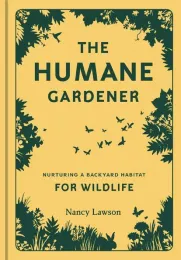
Lawson points out that it is not only the beautiful or charismatic species—such as monarch butterflies—that deserve our concern, but that all species play their part in maintaining a balanced, healthy ecosystem, and that their roles are not always well understood. Scrub jays are often considered a nuisance, yet they are responsible for planting nearly all our wild oak trees. Also, natives are important pollinators, and many wild animals, as well as people, depend on the fruit and seeds of plants they pollinate. Habitat is critical to their success: most nest underground, and other find cavities in twigs, logs, or stems, so a highly manicured landscape is not a suitable habitat for them. Additional pressure can come from a hive of honeybees nearby, which creates competition for resources and may introduce diseases into the native bee population. It is not surprising that some of their species are already extinct, and others are in danger of extinction.
In her book, Lawson makes a compelling case for the value of gardening for habitat, with six content chapters covering topics such as “The Beauty of Letting Go: Let Nature Guide Your Garden”, and “Is your Yard Family Friendly? Provide Baby Food and Nesting Sites”. Numerous color photographs illustrate the text. She makes a number of recommendations for gardeners who wish to increase wildlife habitat, including:
- View plants as potential bird feeders, choosing those that provide seeds and those that support caterpillars, which are such an important food source for baby birds.
- Welcome insects such as dragonflies--which can eat hundreds of mosquitoes a day--and syrphid flies which not only serve as pollinators, but also feed on thrips, scales, mealybugs, spider mites and aphids in their larval stage, into your garden by planting native species to attract a greater diversity of insects.
- Keep leaves in place under trees and shrubs to shelter butterfly pupae and queen bumblebees among other wildlife.
- Be careful with lawn mowers and string trimmers; they can easily injure or kill toads and frogs.
- Prevent window strikes, which kill hundreds of millions of birds each year in the United States, by breaking up the reflection with decals, streamers, or screens.
- Check trees carefully for bird or squirrel nests before pruning or cutting them down.
- Keep cats indoors or confined to a ‘catio' when outside.
- Keep outside lights off at night (or use motion-sensing lights) to avoid harming moths and other nocturnal insects.
- Do not use pesticides; they can have unintended consequences for species other than the one primarily targeted.

Many of the suggestions Lawson offers will sound familiar. What I appreciated most about this book was the overarching message: that we as gardeners can observe nature carefully to better understand the insects, birds, and animals around us, and that we should value the needs and lives of the creatures who share our space.
For more information, go to The Humane Gardener website, or The Humane Gardener YouTube channel. Nancy Lawson was also featured on Margaret Roach's A Way to Garden podcast and The joe gardener Show with Joe Lamp'l.

